Starter Generator Control Module (SGCM) Cooling System
In addition to your vehicle's regular cooling system, your vehicle is also equipped with a cooling system for the SGCM system. This system is serviced differently than the vehicle's main cooling system. The SGCM cooling system includes the SGCM coolant surge tank, SGCM surge tank pressure cap, SGCM cooling pump and the Starter Generator Control Module (SGCM). The SGCM cooling system uses the same type of coolant as the vehicle's regular cooling system, but the two systems operate separately and independently. See "Engine Coolant" and "Cooling System" in the Index of the owner's manual for more information.
When you decide it is safe to lift the hood, here is what you will see:
-

SGCM Coolant Pressure Tank Cap
Starter Generator Control Module (SGCM)
SGCM Cooling Hoses
SGCM Coolant Surge Tank
Engine Coolant Surge Tank and Pressure Cap
SGCM Cooling Pump (Out of View)
If the coolant inside the SGCM coolant surge tank is boiling, do not do anything else until it cools down.
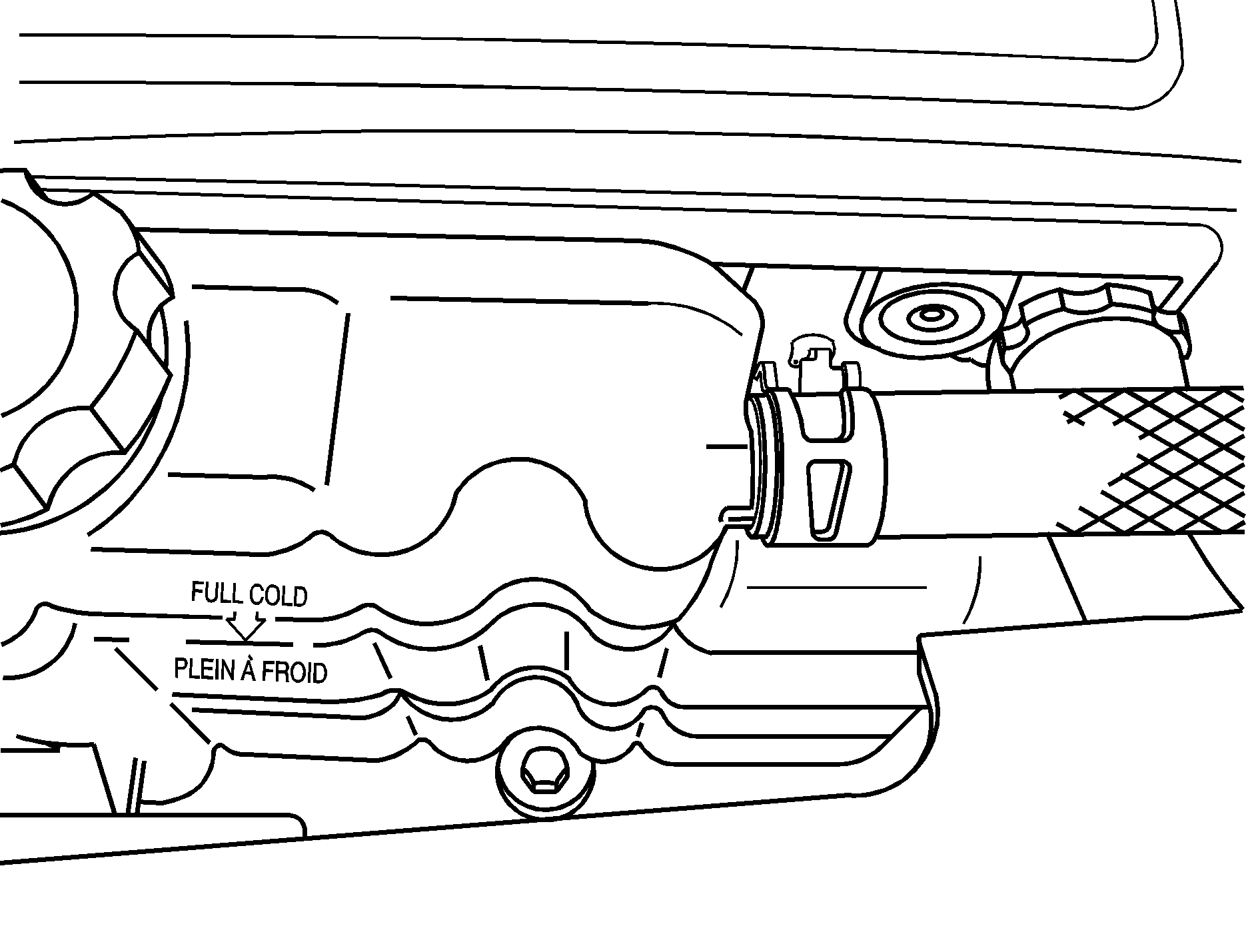
The coolant level should be at or above the FULL COLD mark with the vehicle parked on a level surface. If it is not, you may have a leak at the SGCM heat transfer core, SGCM pressure cap, SGCM auxiliary radiator hoses, SGCM cooling pump or somewhere else in the SGCM cooling system.
Notice: Running the engine when there is a leak in the hybrid cooling system can cause the hybrid cooling system to lose all coolant and can damage the system. Get any leak fixed before you drive the vehicle or run the engine.
How to Add Coolant to the SGCM Coolant Surge Tank

If you have not found a problem yet, check to see if coolant is visible in the SGCM coolant surge tank. If coolant is visible and within one inch (2.54 cm) of the FULL COLD mark, add a 50/50 mixture of clean, drinkable water and DEX-COOL® coolant at the SGCM coolant surge tank, but be sure the SGCM cooling system, including the SGCM coolant surge tank pressure cap, is cool before you do it. Use the procedure following.
Caution: Steam and scalding liquids from a hot cooling system can blow out and burn you badly. They are under pressure, and if you turn the coolant surge tank pressure cap -- even a little -- they can come out at high speed. Never turn the cap when the cooling system, including the coolant surge tank pressure cap, is hot. Wait for the cooling system and coolant surge tank pressure cap to cool if you ever have to turn the pressure cap.
Notice: Using coolant other than DEX-COOL may damage your vehicle. Any repairs would not be covered by your warranty. Always use DEX-COOL (silicate-free) coolant in your vehicle.
Caution: You can be burned if you spill coolant on hot engine parts. Coolant contains ethylene glycol and it will burn if the engine parts are hot enough. Do not spill coolant on a hot engine.
If the SGCM coolant is more than one inch (2.54 cm) below the FULL COLD mark, your vehicle must be serviced by your dealer and a special fill procedure must be followed.
Notice: Attempting to fill the hybrid cooling surge tank yourself when the fluid level is more than 1 inch (2.54 cm) below the FULL COLD mark can damage your vehicle. Your vehicle must be serviced.
- Park the vehicle on a level surface and turn the vehicle off. You can remove the SGCM coolant surge tank pressure cap when the SGCM cooling system, including the SGCM coolant surge tank pressure cap and SGCM cooling hoses, are no longer hot. Turn the SGCM coolant surge tank pressure cap slowly counterclockwise (left) about one full turn. Wait 30 seconds.
- Then keep turning the SGCM coolant surge tank pressure cap slowly, and remove it.
- Add the proper coolant mixture to the SGCM coolant surge tank until the level reaches the FULL COLD mark.
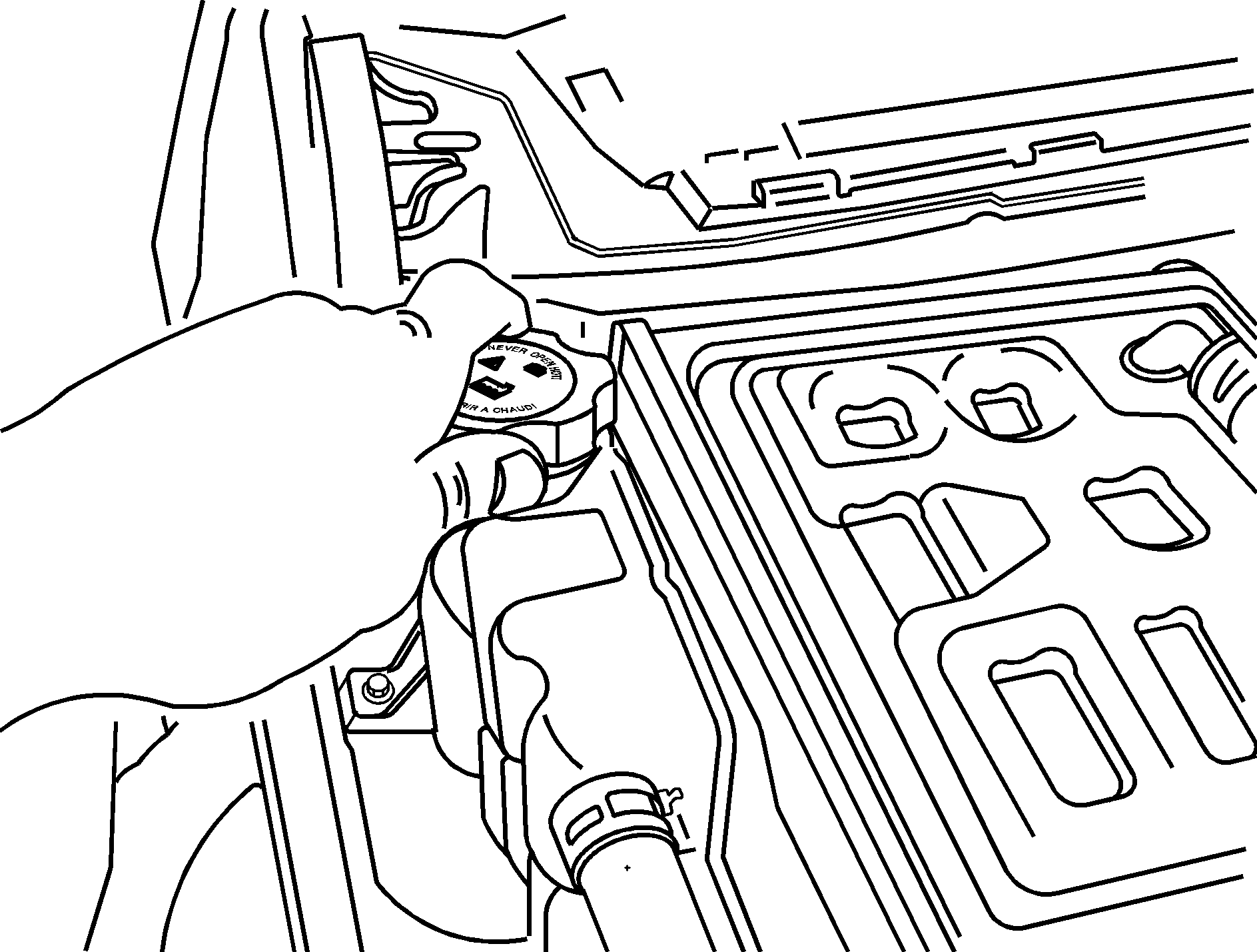
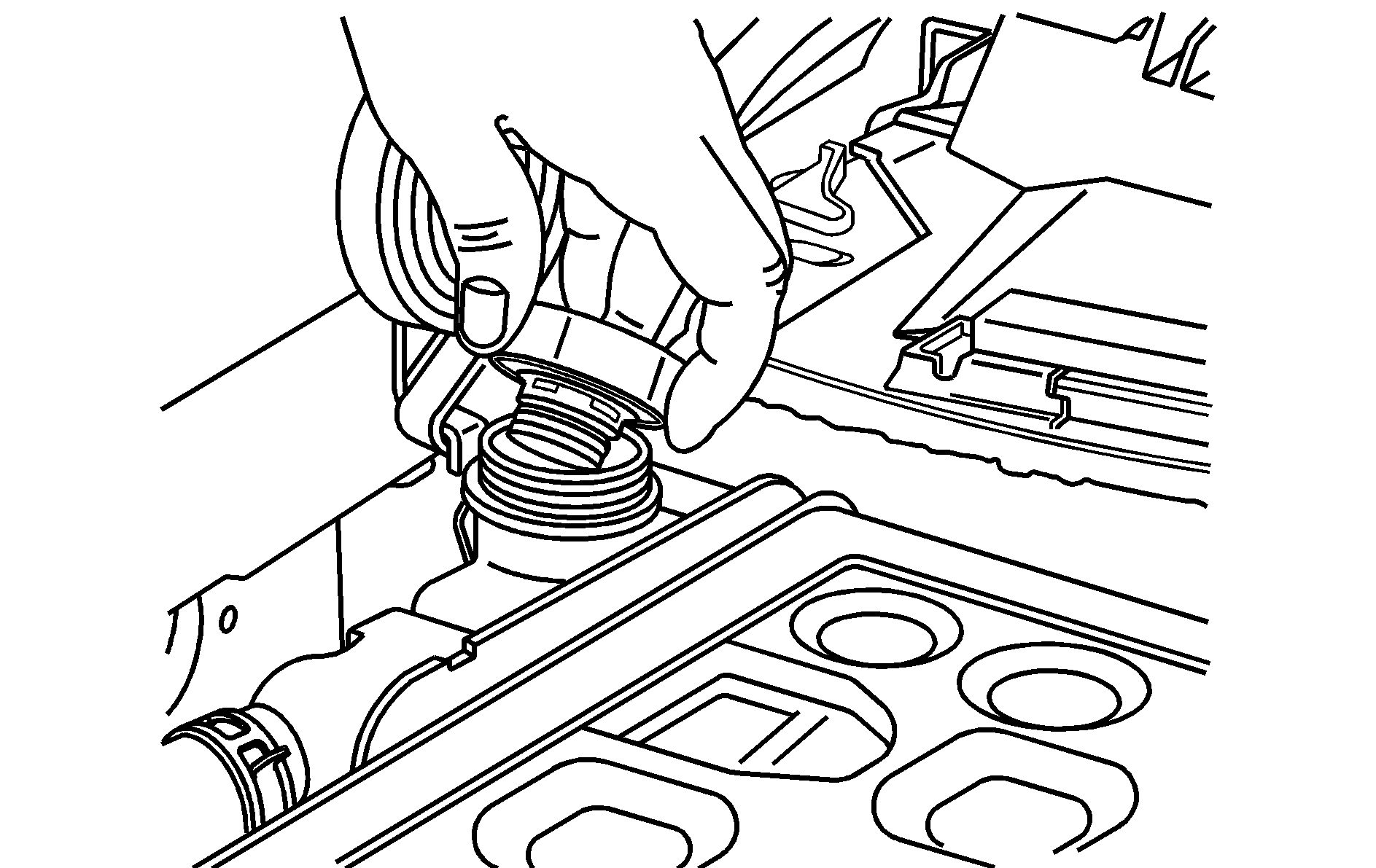
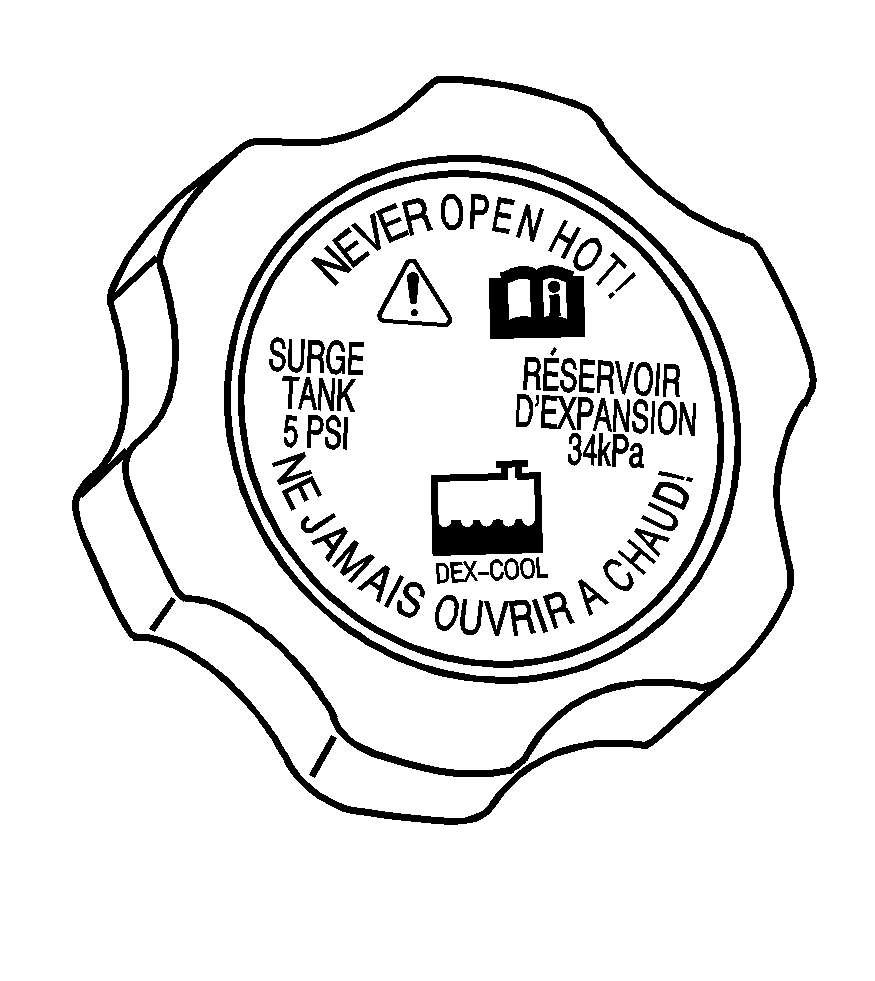
Then replace the SGCM coolant surge tank pressure cap. Be sure the pressure cap is hand-tight and fully seated.
Notice: Using cooling system sealers or conditioners in an attempt to stop coolant leaks can damage the SGCM and engine cooling systems. Never use cooling system sealers or conditioners in your cooling system.
Pickup Models
When you decide it's safe to lift the hood, here's what you'll see:
-

Coolant Surge Tank Pressure Cap
Coolant Surge Tank
Engine Fan
If the coolant inside the coolant surge tank is boiling, don't do anything else until it cools down. The vehicle should be parked on a level surface.
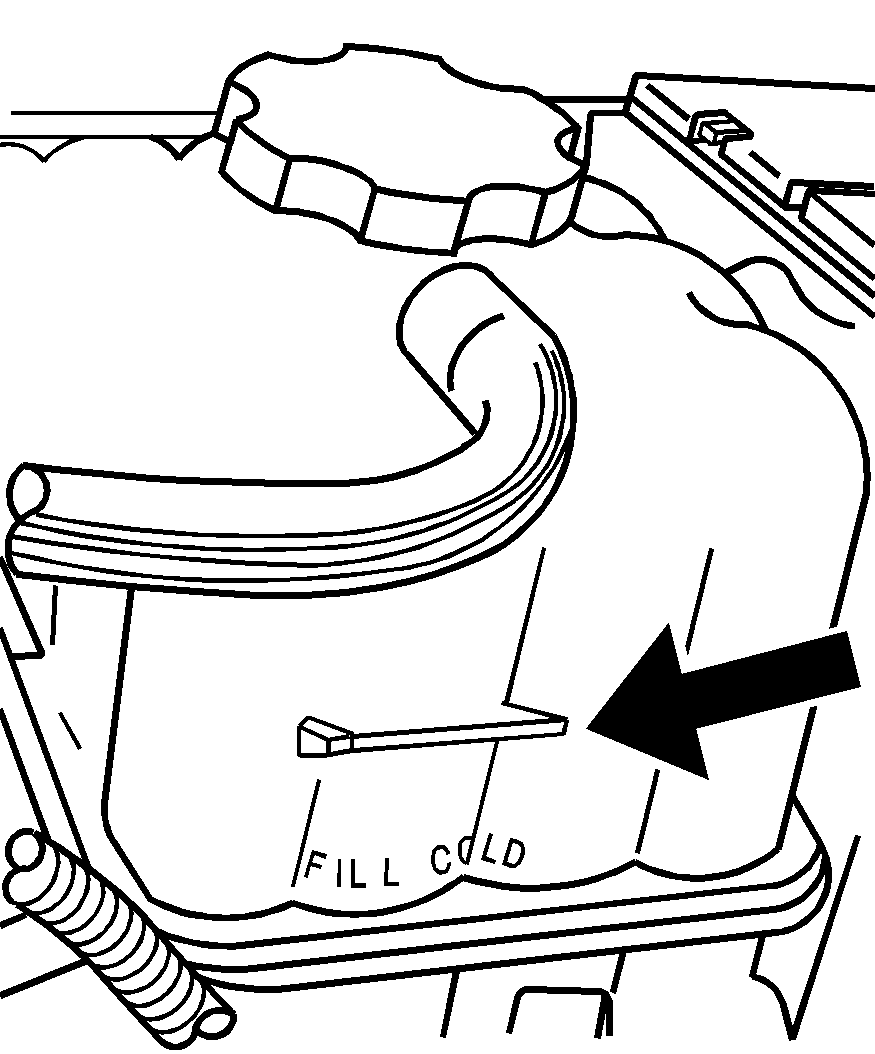
The coolant level should be at or above the FULL COLD mark. If it isn't, you may have a leak at the pressure cap or in the radiator hoses, heater hoses, radiator, water pump or somewhere else in the cooling system.
Caution: Heater and radiator hoses, and other engine parts, can be very hot. Do not touch them. If you do, you can be burned.
Do not run the engine if there is a leak. If you run the engine, it could lose all coolant. That could cause an engine fire, and you could be burned. Get any leak fixed before you drive the vehicle.If there seems to be no leak, start the engine again. If your vehicle is equipped with an engine driven cooling fan, the engine cooling fan speed should increase when idle speed is doubled by pushing the accelerator pedal down. If it doesn't, your vehicle needs service. Turn off the engine.
Notice: Engine damage from running the engine without coolant is not covered by the warranty.
Notice: Using coolant other than DEX-COOL® can cause premature engine, heater core, or radiator corrosion. In addition, the engine coolant could require changing sooner, at 30,000 miles (50 000 km) or 24 months, whichever occurs first. Any repairs would not be covered by the vehicle warranty. Always use DEX-COOL® (silicate-free) coolant in the vehicle.
How to Add Coolant to the Coolant Surge Tank
Notice: The diesel engine has a specific coolant fill procedure. Failure to follow this procedure could cause your engine to overheat and be severely damaged.
If you haven't found a problem yet, check to see if coolant is visible in the surge tank. If coolant is visible but the coolant level isn't at or above the FULL COLD mark, add a 50/50 mixture of clean, drinkable water and DEX-COOL® coolant at the coolant surge tank, but be sure the cooling system, including the coolant surge tank pressure cap, is cool before you do it. See Engine Coolant for more information.
If no coolant is visible in the surge tank, add coolant as follows:
Caution: Steam and scalding liquids from a hot cooling system can blow out and burn you badly. They are under pressure, and if you turn the coolant surge tank pressure cap -- even a little -- they can come out at high speed. Never turn the cap when the cooling system, including the coolant surge tank pressure cap, is hot. Wait for the cooling system and coolant surge tank pressure cap to cool if you ever have to turn the pressure cap.
Caution: Adding only plain water to the cooling system can be dangerous. Plain water, or some other liquid such as alcohol, can boil before the proper coolant mixture will. The vehicle's coolant warning system is set for the proper coolant mixture. With plain water or the wrong mixture, the engine could get too hot but you would not get the overheat warning. The engine could catch fire and you or others could be burned. Use a 50/50 mixture of clean, drinkable water and DEX-COOL® coolant.
Notice: In cold weather, water can freeze and crack the engine, radiator, heater core and other parts. Use the recommended coolant and the proper coolant mixture.
Caution: You can be burned if you spill coolant on hot engine parts. Coolant contains ethylene glycol and it will burn if the engine parts are hot enough. Do not spill coolant on a hot engine.
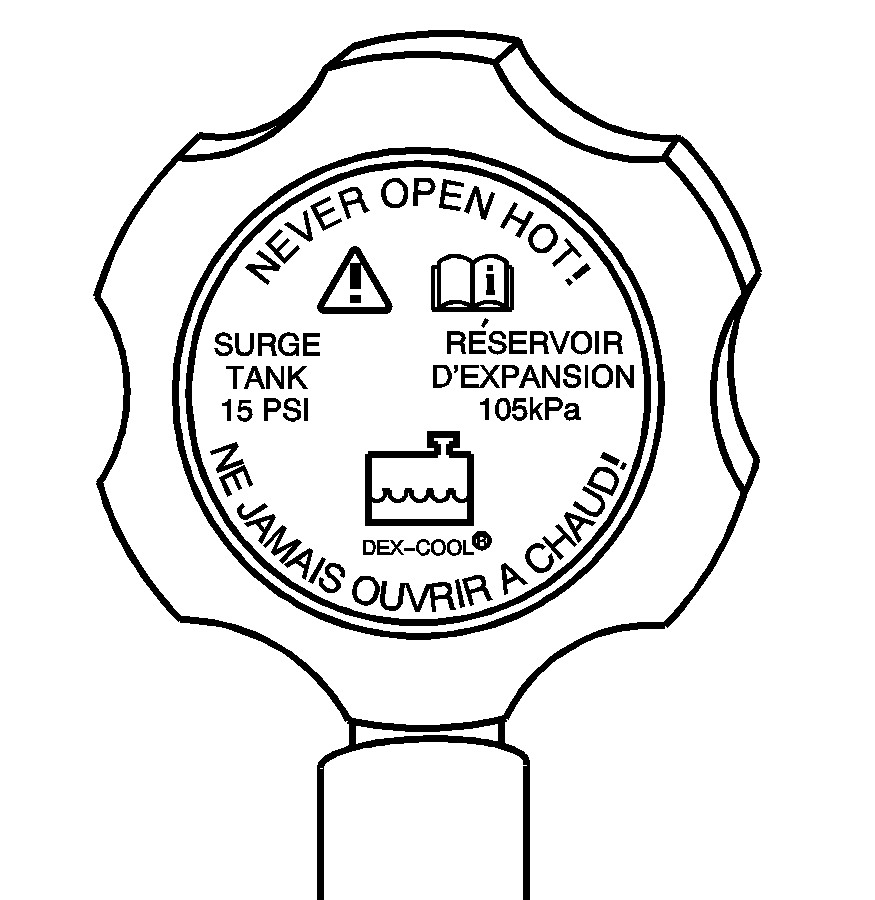
Park the vehicle on a level surface. You can remove the coolant surge tank pressure cap when the cooling system, including the coolant surge tank pressure cap and upper radiator hose, is no longer hot.
- Turn the pressure cap slowly counterclockwise (left) until it first stops. Don't press down while turning the pressure cap. If you hear a hiss, wait for that to stop. A hiss means there is still some pressure left.
- Then keep turning the cap, but now push down as you turn it. Remove the pressure cap.
- After the engine cools, open the air bleed valve on the thermostat housing.
- Close the bleed valve.
- Rinse or wipe the spilled coolant from the engine and compartment.
- Then fill the coolant surge tank with the proper mixture, to slightly above the fill mark.
- With the coolant surge tank pressure cap off, start the engine and let it run until you can feel the upper radiator hose getting hot. Watch out for the engine cooling fan.
- Then replace the pressure cap.
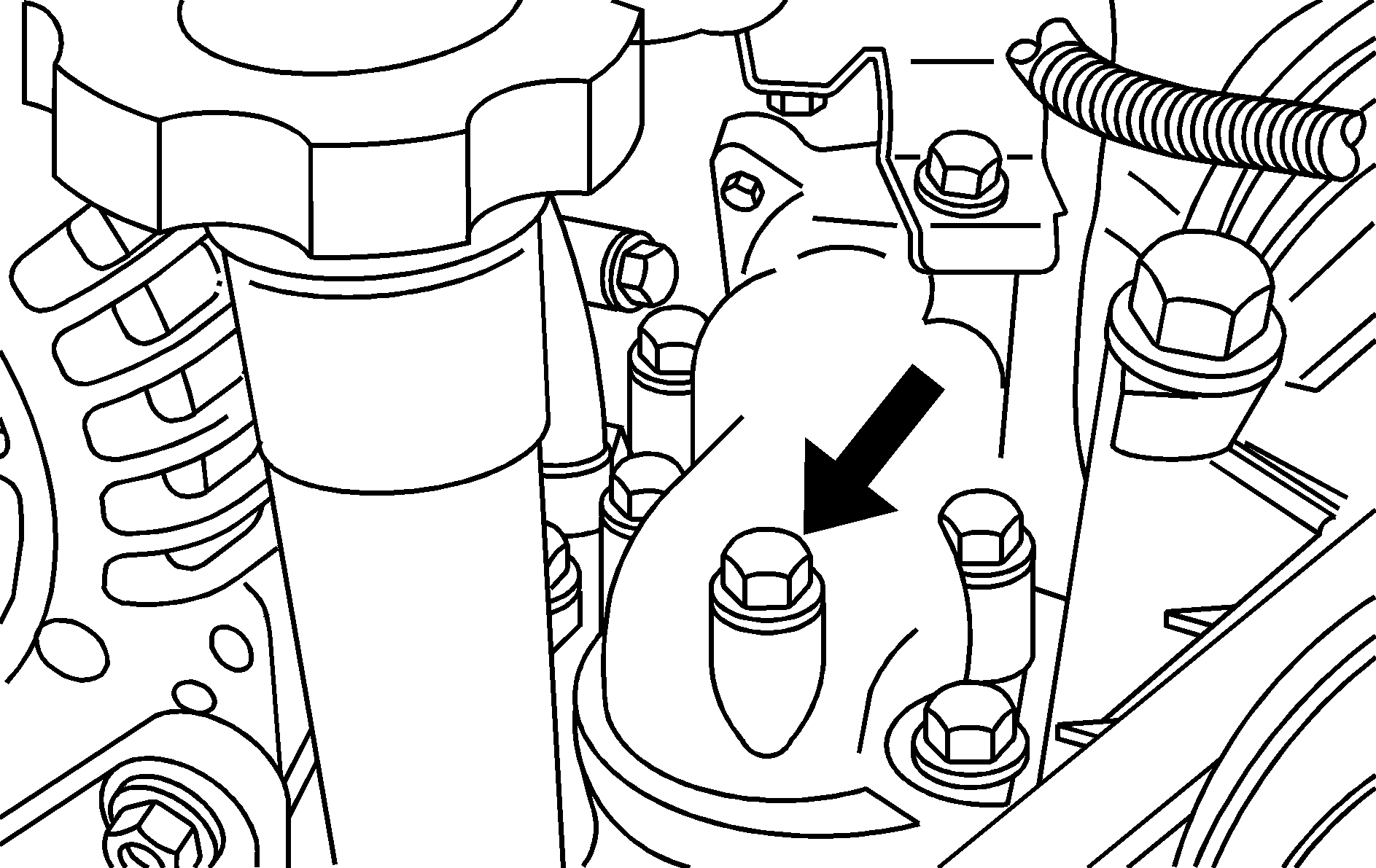
Fill with the proper mixture. Add coolant until you see a steady stream of coolant coming from the bleed valve.

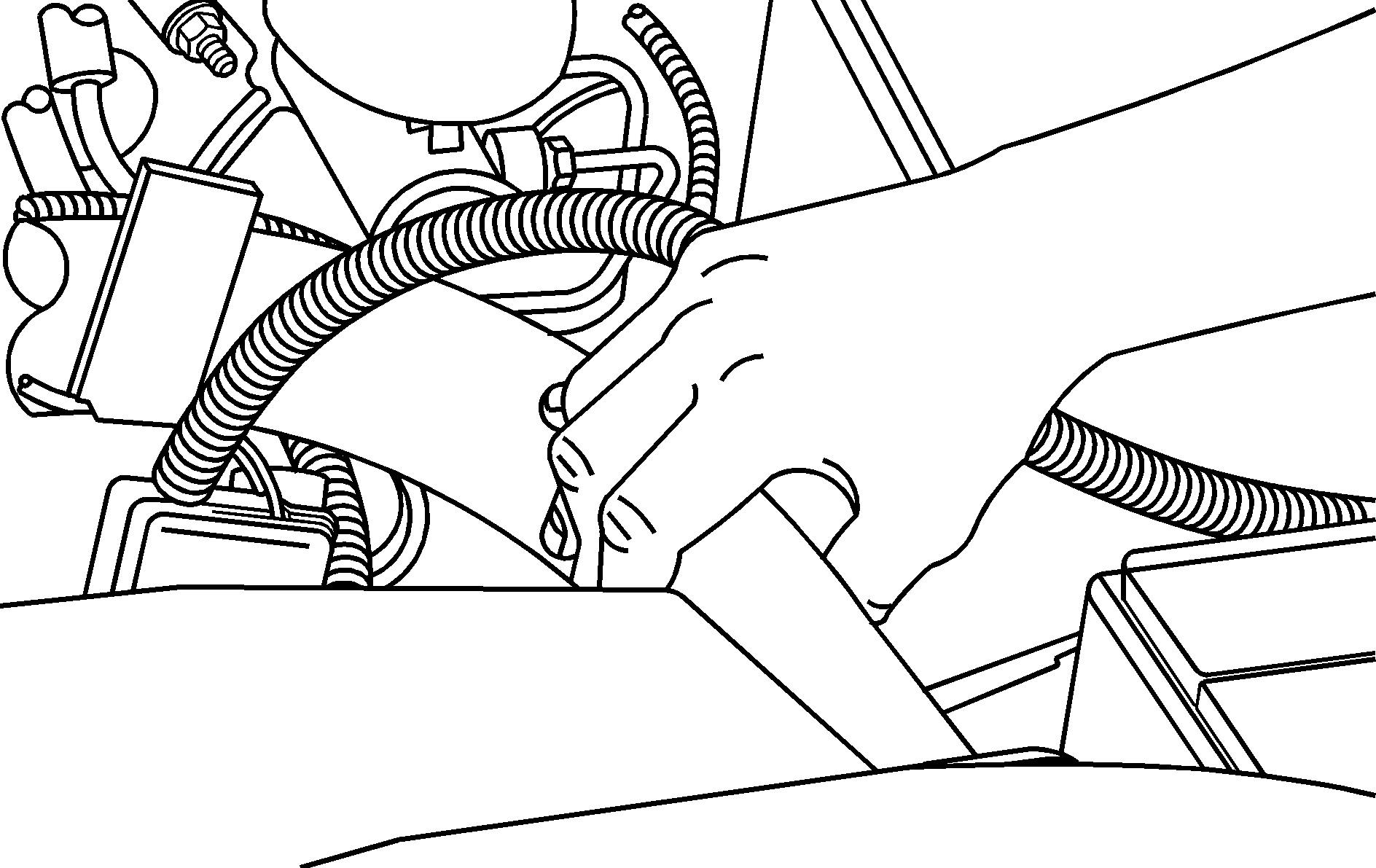
By this time, the coolant level inside the coolant surge tank may be lower. If the level is lower, add more of the proper mixture to the coolant surge tank until the level reaches the FULL COLD mark.
Van Models
When you decide it is safe to lift the hood, here is what you will see:
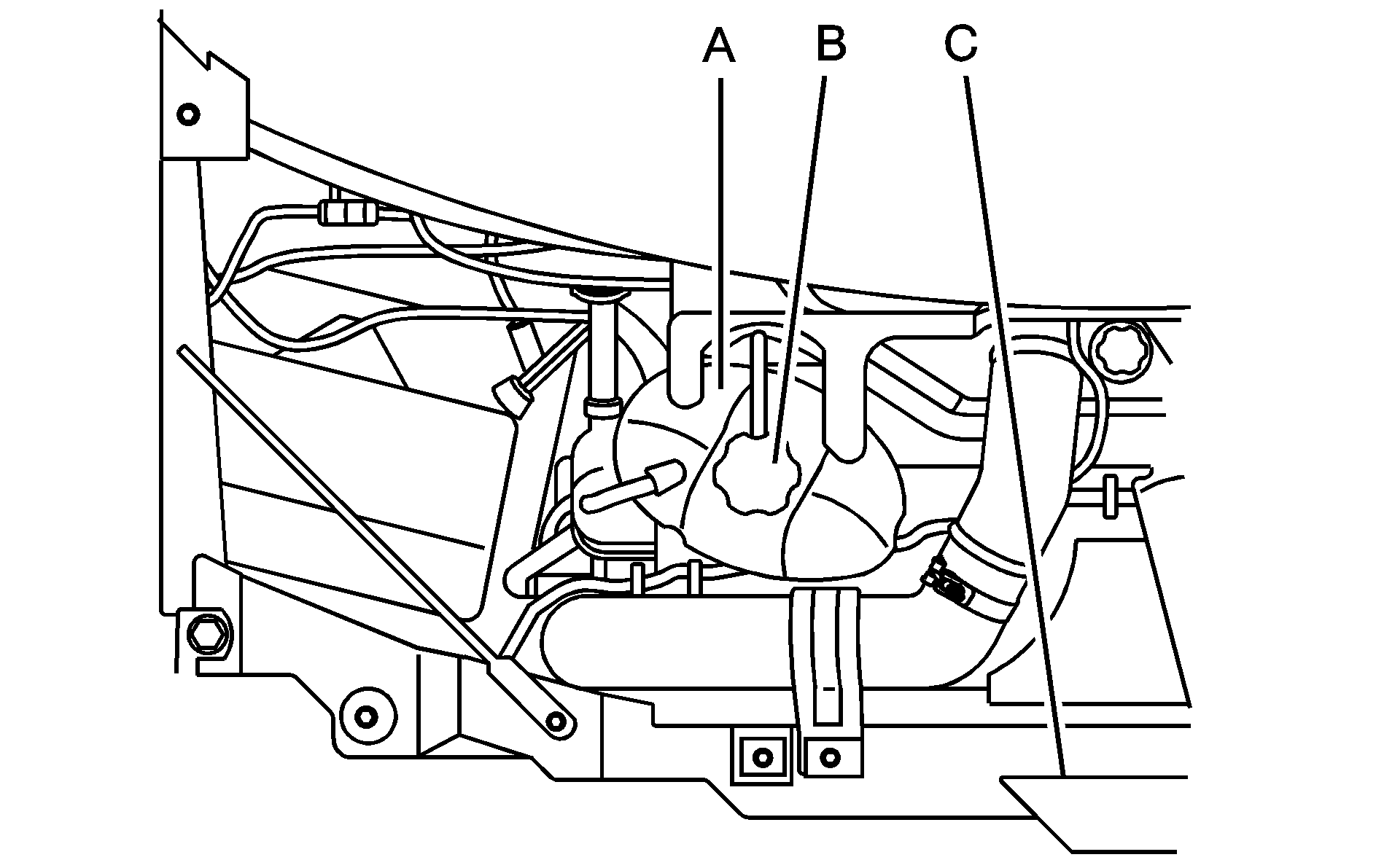
Coolant Surge Tank
Coolant Surge Tank Pressure Cap
Engine Cooling Fan
If the coolant inside the coolant surge tank is boiling, do not do anything else until it cools down.

When the engine is cold, the coolant level should be at or above the COLD FILL mark.
If it is not, you may have a leak at the pressure cap or in the radiator hoses, heater hoses, radiator, water pump, fuel operated heater (FOH) or somewhere else in the cooling system.
Caution: Heater and radiator hoses, and other engine parts, can be very hot. Do not touch them. If you do, you can be burned.
Do not run the engine if there is a leak. If you run the engine, it could lose all coolant. That could cause an engine fire, and you could be burned. Get any leak fixed before you drive the vehicle.If there seems to be no leak, start the engine again. See if the engine cooling fan speed increases when idle speed is doubled by pushing the accelerator pedal down. If it does not, your vehicle needs service. Turn off the engine.
Notice: Engine damage from running the engine without coolant is not covered by the warranty.
Notice: Using coolant other than DEX-COOL may cause premature engine, heater core, radiator and fuel operated heater (FOH) corrosion. In addition, the engine coolant may require changing sooner, at 30,000 miles (50 000 km) or 24 months, whichever occurs first. Any repairs would not be covered by your warranty. Always use DEX-COOL (silicate-free) coolant in your vehicle.
How to Add Coolant to the Coolant Surge Tank
Notice: The diesel engine has a specific coolant fill procedure. Failure to follow this procedure could cause your engine to overheat and be severely damaged.
If you have not found a problem yet, but the coolant level is not at the COLD FILL mark, add a 50/50 mixture of clean, drinkable water and DEX-COOL® engine coolant at the coolant surge tank. See Engine Coolant for more information.
If no coolant is visible in the surge tank, add coolant as follows:
Caution: Steam and scalding liquids from a hot cooling system can blow out and burn you badly. They are under pressure, and if you turn the coolant surge tank pressure cap -- even a little -- they can come out at high speed. Never turn the cap when the cooling system, including the coolant surge tank pressure cap, is hot. Wait for the cooling system and coolant surge tank pressure cap to cool if you ever have to turn the pressure cap.
Caution: Adding only plain water to the cooling system can be dangerous. Plain water, or some other liquid such as alcohol, can boil before the proper coolant mixture will. The vehicle's coolant warning system is set for the proper coolant mixture. With plain water or the wrong mixture, the engine could get too hot but you would not get the overheat warning. The engine could catch fire and you or others could be burned. Use a 50/50 mixture of clean, drinkable water and DEX-COOL® coolant.
Notice: In cold weather, water can freeze and crack the engine, radiator, fuel operated heater (FOH), heater core and other parts. Use the recommended coolant and the proper coolant mixture.
Caution: You can be burned if you spill coolant on hot components in the engine compartment. Coolant contains ethylene glycol, and it will burn if the engine parts are hot enough. Do not spill coolant on a hot engine or components in the engine compartment.
When the coolant in the coolant surge tank is at the COLD FILL mark, start your vehicle.
- You can remove the coolant surge tank pressure cap when the cooling system, including the coolant surge tank pressure cap and upper radiator hose, is no longer hot. Turn the pressure cap slowly counterclockwise about one full turn.
- Then keep turning the pressure cap slowly, and remove it.
- Fill the coolant surge tank with the proper mixture, up to the FULL COLD mark. See Engine Coolant
- With the coolant surge tank pressure cap off, start the engine and let it run until you can feel the upper radiator hose getting hot. Watch out for the engine cooling fan. By this time, the coolant level inside the coolant surge tank may be lower. If the level is lower, add more of the proper mixture to the coolant surge tank until the level reaches the FULL COLD mark.
- Then replace the pressure cap. Be sure the pressure cap is hand-tight and fully seated.

If you hear a hiss, wait for that to stop. A hiss means there is still some pressure left.
If your vehicle has the DURAMAX Diesel engine, see the DURAMAX Diesel manual for more information.
When you decide it is safe to lift the hood, here is what you will see:
8.1L V8 Engines
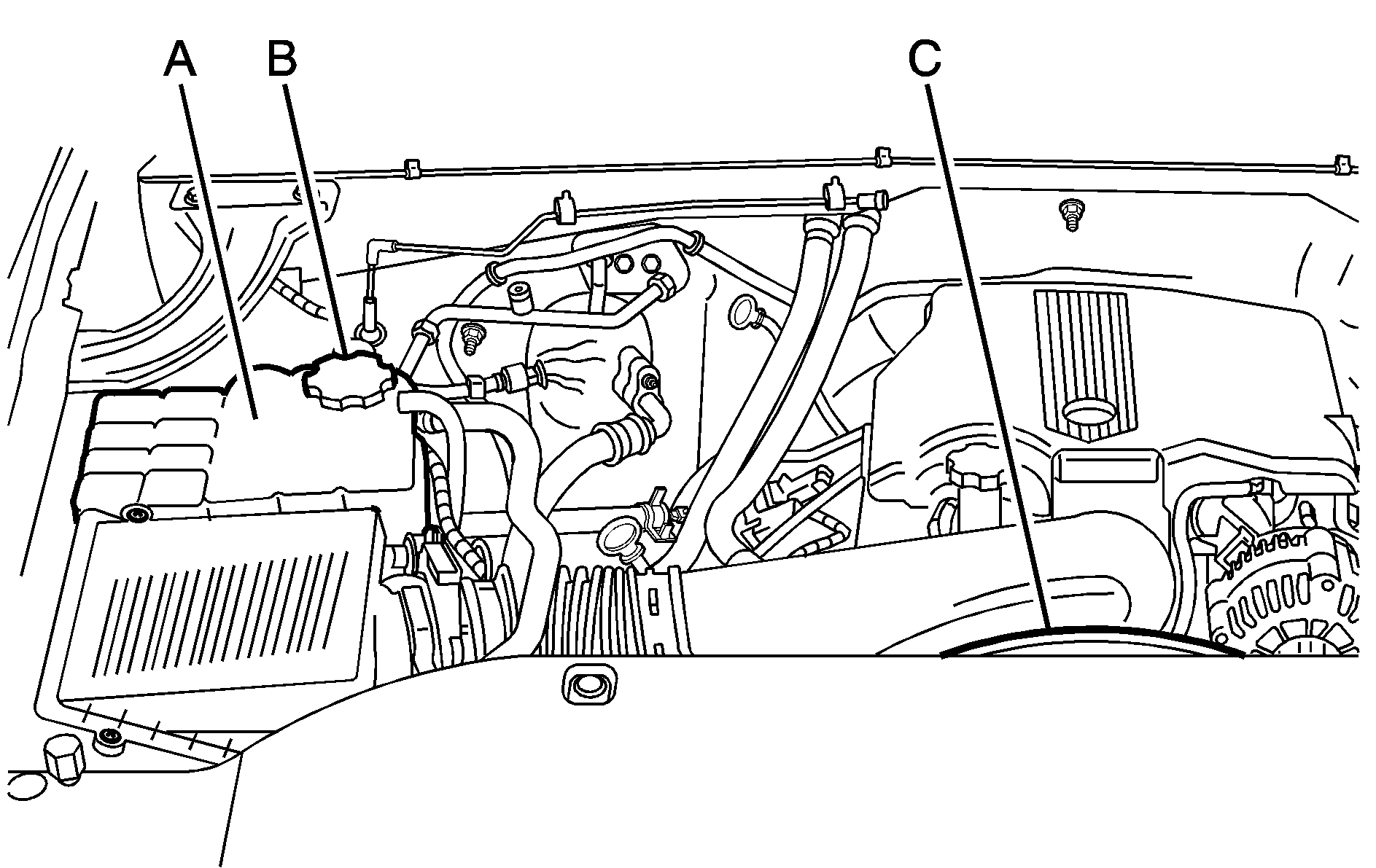
Coolant Surge Tank
Coolant Surge Tank Pressure Cap
Engine Cooling Fan
All Other Engines
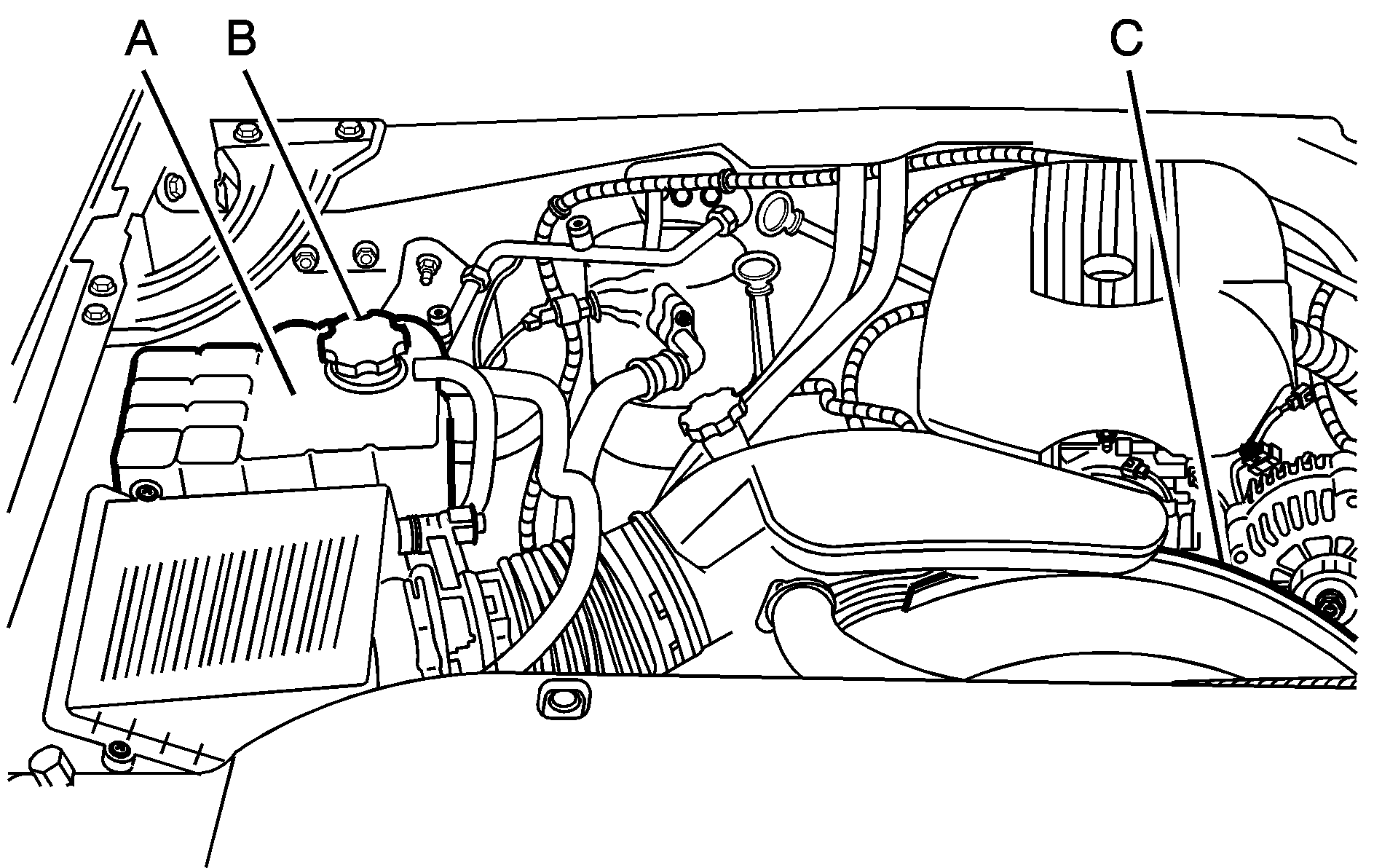
Coolant Surge Tank
Coolant Surge Tank Pressure Cap
Engine Cooling Fan
Caution: An electric fan under the hood can start up and injure you even when the engine is not running. Keep hands, clothing, and tools away from any underhood electric fan.
If the coolant inside the coolant surge tank is boiling, do not do anything else until it cools down. The vehicle should be parked on a level surface. Check the coolant level after the system cools down. Some amount of coolant may be lost due to overheating.
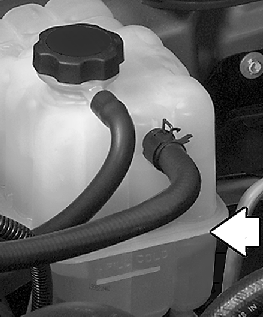
The coolant level should be at or above the FULL COLD mark. If it is not, you may have a leak at the pressure cap or in the radiator hoses, heater hoses, radiator, water pump, or somewhere else in the cooling system.
Caution: Heater and radiator hoses, and other engine parts, can be very hot. Do not touch them. If you do, you can be burned.
Do not run the engine if there is a leak. If you run the engine, it could lose all coolant. That could cause an engine fire, and you could be burned. Get any leak fixed before you drive the vehicle.If your vehicle has an electric engine cooling fan, check the coolant temperature gage. If the coolant temperature is approximately 232°F (111°C), the electric cooling fan should be running. If it is not, your vehicle needs service. Turn off the engine.
If your vehicle has an engine-driven cooling fan, start the engine again and see if the fan speed increases when idle speed is doubled by pushing the accelerator pedal down. If it does not, your vehicle needs service. Turn off the engine.
Notice: Engine damage from running your engine without coolant is not covered by your warranty. See Overheated Engine Protection Operating Mode for information on driving to a safe place in an emergency.
Notice: Using coolant other than DEX-COOL® can cause premature engine, heater core, or radiator corrosion. In addition, the engine coolant could require changing sooner, at 30,000 miles (50 000 km) or 24 months, whichever occurs first. Any repairs would not be covered by the vehicle warranty. Always use DEX-COOL® (silicate-free) coolant in the vehicle.
How to Add Coolant to the Coolant Surge Tank for Gasoline Engines
If your vehicle has a diesel engine, see "Cooling System" in the DURAMAX® Diesel Supplement for the proper coolant fill procedure.
If you have not found a problem yet, check to see if coolant is visible in the surge tank. If coolant is visible but the coolant level is not at or above the FULL COLD mark, add a 50/50 mixture of clean, drinkable water and DEX-COOL® coolant at the coolant surge tank, but be sure the cooling system, including the coolant surge tank pressure cap, is cool before you do it. See Engine Coolant for more information.
If no coolant is visible in the surge tank, add coolant as follows:
Caution: Steam and scalding liquids from a hot cooling system can blow out and burn you badly. They are under pressure, and if you turn the coolant surge tank pressure cap -- even a little -- they can come out at high speed. Never turn the cap when the cooling system, including the coolant surge tank pressure cap, is hot. Wait for the cooling system and coolant surge tank pressure cap to cool if you ever have to turn the pressure cap.
Caution: Adding only plain water to your cooling system can be dangerous. Plain water, or some other liquid such as alcohol, can boil before the proper coolant mixture will. Your vehicle's coolant warning system is set for the proper coolant mixture. With plain water or the wrong mixture, your engine could get too hot but you would not get the overheat warning. Your engine could catch fire and you or others could be burned. Use a 50/50 mixture of clean, drinkable water and a proper coolant.
Notice: In cold weather, water can freeze and crack the engine, radiator, heater core and other parts. Use the recommended coolant and the proper coolant mixture.
Caution: You can be burned if you spill coolant on hot engine parts. Coolant contains ethylene glycol and it will burn if the engine parts are hot enough. Do not spill coolant on a hot engine.
- Turn the pressure cap slowly counterclockwise about one full turn. If you hear a hiss, wait for that to stop. A hiss means there is still some pressure left.
- Then keep turning the pressure cap slowly, and remove it.
- Fill the coolant surge tank with the proper mixture, to the FULL COLD mark.
- With the coolant surge tank pressure cap off, start the engine and let it run until you can feel the upper radiator hose getting hot. Watch out for the engine cooling fan.
- Then replace the pressure cap. Be sure the pressure cap is hand-tight and fully seated.
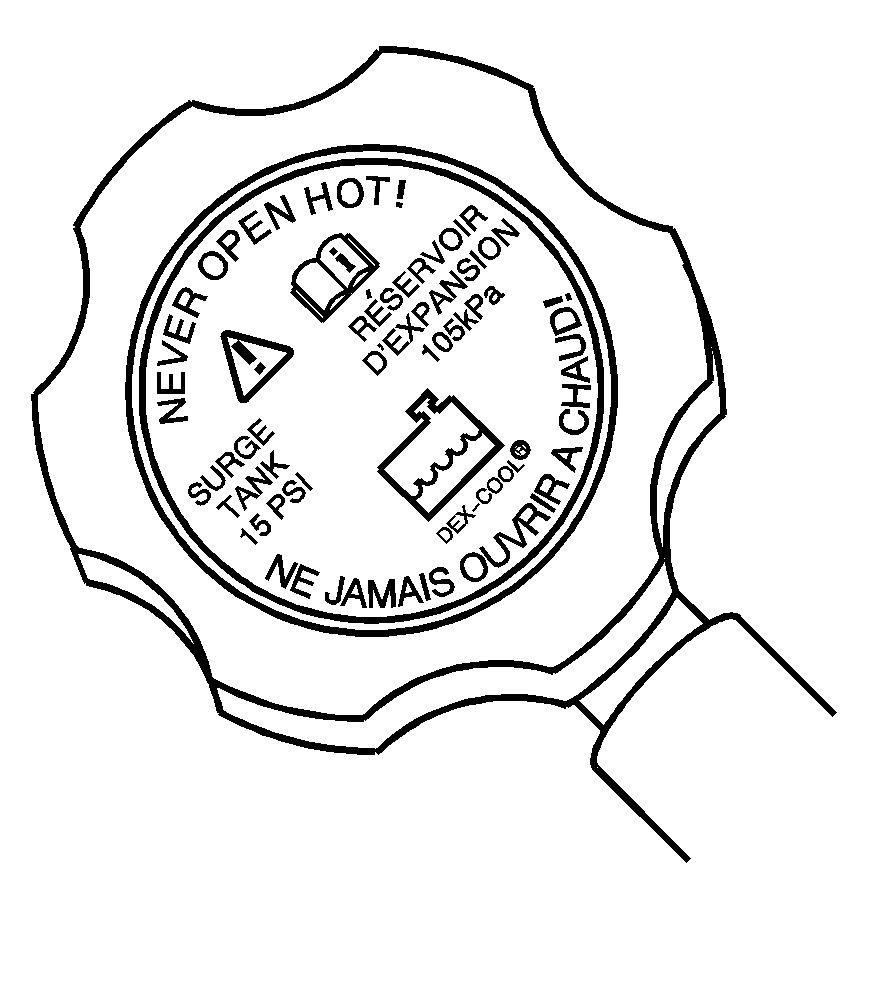
You can remove the coolant surge tank pressure cap when the cooling system, including the coolant surge tank pressure cap and upper radiator hose, is no longer hot.
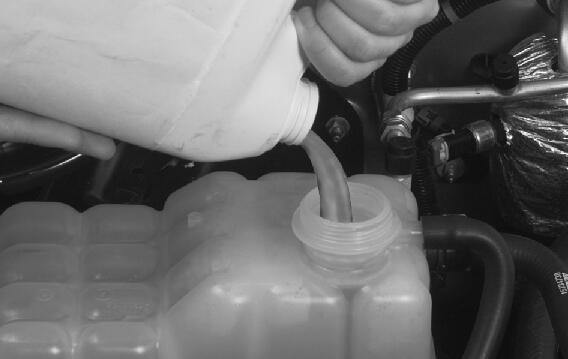
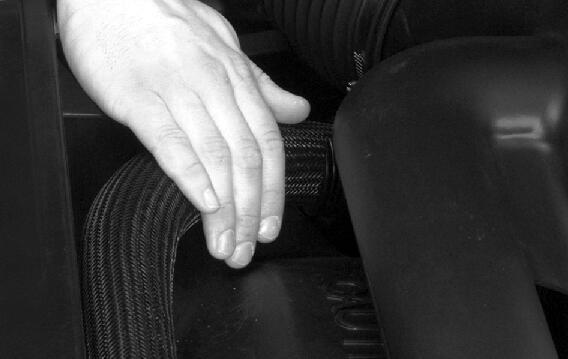
By this time, the coolant level inside the coolant surge tank may be lower. If the level is lower, add more of the proper mixture to the coolant surge tank until the level reaches the FULL COLD mark.
